Spotted Lanternfly prevention practices for producers
Learn about identifying and preventing the spread of Spotted Lanternfly.
Introduction
Spotted lanternfly (Lycorma delicatula, SLF) is an invasive planthopper that threatens Ontario’s agricultural sector. The pest was accidentally introduced to the United States (US) from its native range in China and has since spread to multiple states in the mid-Atlantic, including those bordering Ontario. Due to the proximity of the pest and the numerous pathways for entry, the risk of introduction to Canada is considered very high. To help mitigate against the spread, the Canadian Food Inspection Agency (CFIA) added SLF to their list of regulated pests in 2018.
Although SLF has a large host range that includes crops and landscape plants, grapevines are at risk of plant injury or death due to swarm feeding by adults as they move from senescing hosts into vineyards in the late summer and fall. Canopy dieback and plant health decline have been recorded in saplings of some landscape trees such as black walnut and red/silver maple, especially those stressed by environmental conditions. Dieback and death have also been observed in the invasive tree of heaven, a preferred host of SLF. More research is needed to determine the impact to other host plants and to overall ecosystem health. SLF is currently considered to be primarily a nuisance pest in residential landscapes.
Spread
Long distance spread is typically associated with people inadvertently moving overwintering egg masses. Female SLF lay their eggs on flat surfaces, including host plants and non-plant material such as pallets, landscaping stones, outdoor furniture, and equipment, pots, firewood, trailers, and vehicles.
Nursery stock and softwood lumber with bark (including firewood) are considered important pathways for spread to new areas. Consequently, the CFIA established import requirements for all nursery stock and softwood lumber with bark from the continental US as a measure to reduce the risk of spreading SLF to Canada through this pathway. If SLF is detected in Canada, nursery stock located in regulated areas will be subject to phytosanitary measures to ensure materials are pest-free prior to domestic movement. For information on all other pathways and products, including both reporting requirements and risk mitigation measures (such as removal of all life stages) for regulated articles out of an SLF regulated area, visit the Canadian Food Inspection Agency’s website.
Prevention
Preventing introduction is the most critical step you can take to help protect your business. The most common way for SLF to spread to new geographic areas is via egg masses, making it critically important to inspect all supplies and associated vehicles when they arrive at and before they leave your operation. Movement of adults, especially mated females, presents an additional risk for introduction and potential establishment. To lower the risk of introducing SLF:
- Work with suppliers to determine if they are in an area with established SLF populations.
- Check the distribution map for SLF in the US.
- Ask about your suppliers’ management and inspection programs, including what steps they use to exclude SLF in shipment staging and loading areas. Periods of high risk for moving egg masses are late September through early May and July to December for adults.
- Train staff and workers to identify SLF life stages and to understand its seasonal biology and host use.
- Isolate goods coming from known infested areas in a designated holding area prior to storage or use at your operation.
- Inspect all incoming shipping vehicles, farm equipment and associated supplies including plants, pallets, crates, tarps, toolboxes, and containers.
- Make sure to check vehicle wheel wells, truck beds and caps, and other recesses (grooves, small spaces etc.), and under any protective wrapping. Egg masses are often mistaken for splotches of mud. Use a flashlight to improve visibility.
- Establish visitor and supplier parking away from preferred landscape hosts and from production areas.
- Contact the CFIA immediately if any suspect SLF life stage is detected. Contact the CFIA through the contact page.
Best management practices have been developed by the Canadian Nursery Certification Institute to provide nursery farms guidance on preventing the entry of SLF to their farms through imports and incursions from infested areas. Many of these risk-reduction practices have application across production systems. If SLF is detected in Canada, these BMPs also outline practices that can prevent and manage the incursion of SLF from the outside environment.
Identification
Spotted lanternfly has one generation per year and overwinters in the egg stage (Figure 1). In the fall, mated females lay rows of tan coloured eggs, with 30 to 50 per mass. Eggs are covered by a protective white waxy coating that turns grey-brown, dries, and cracks over time (Figure 2). Some egg masses may be partially covered, or they may be completely exposed. Eggs are cold tolerant and are expected to survive winters in southern Ontario.
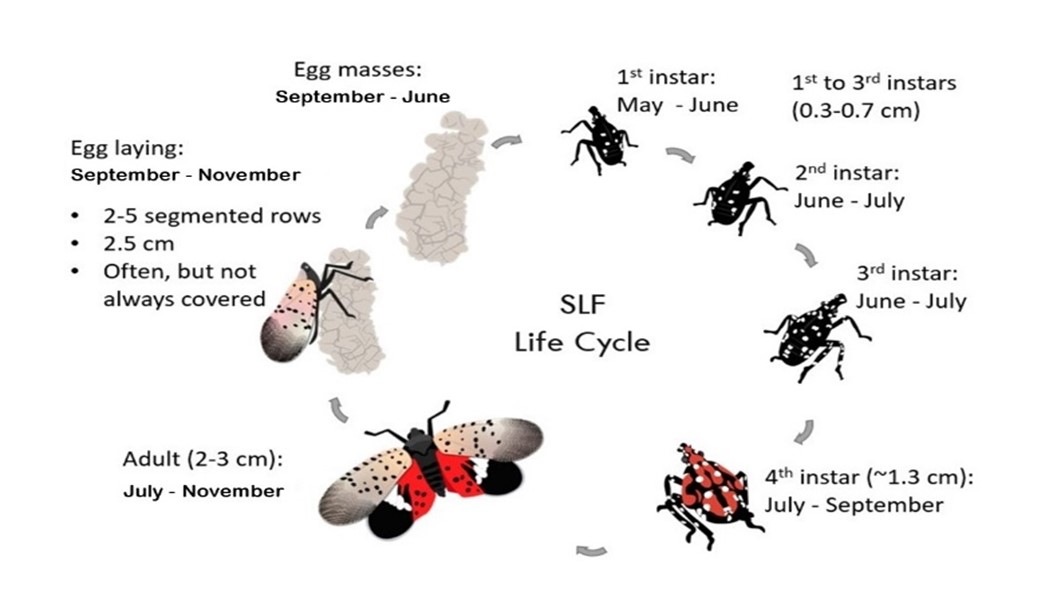
Accessible description for Figure 1
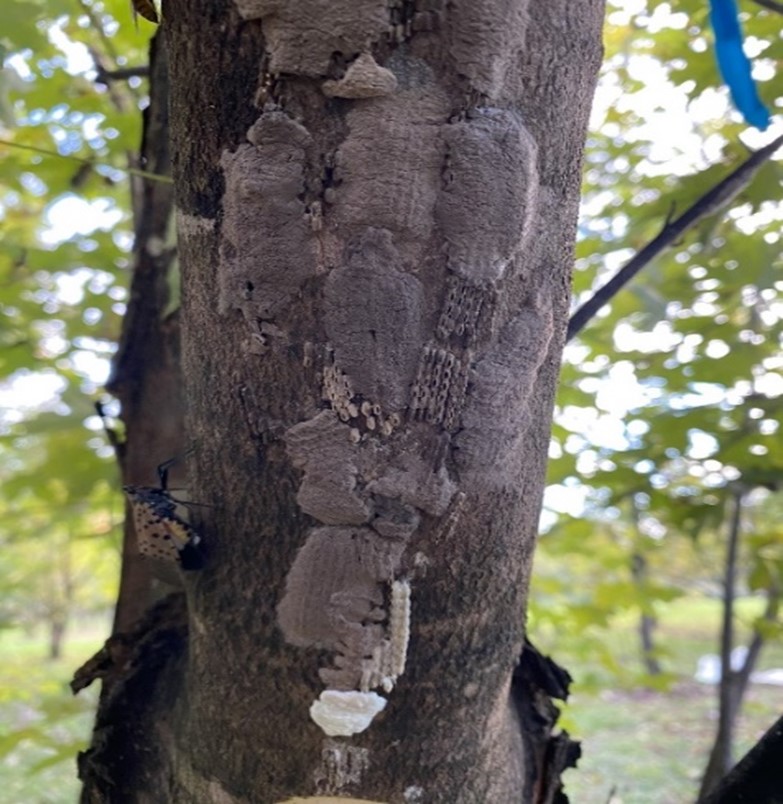
Nymphs hatch from eggs in the spring (Figure 3) and progress through four developmental stages known as instars. The first three instar stages are black with white spots and the fourth is bright red with white spots and black bands and approximately 13 to 15 millimetres (mm) in length (Figure 4). All nymphs are strong jumpers and are highly mobile. Early instars have a broad host range and feed on young, tender shoots of perennial and annual plants. Fourth instar nymphs and adults typically restrict their feeding to woody tissues of grapevines, walnut, maple, birch, tree of heaven and other hardwood species.
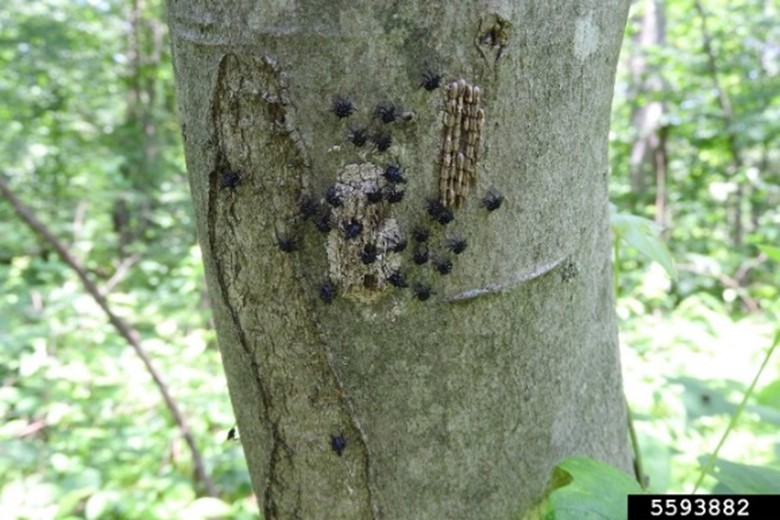
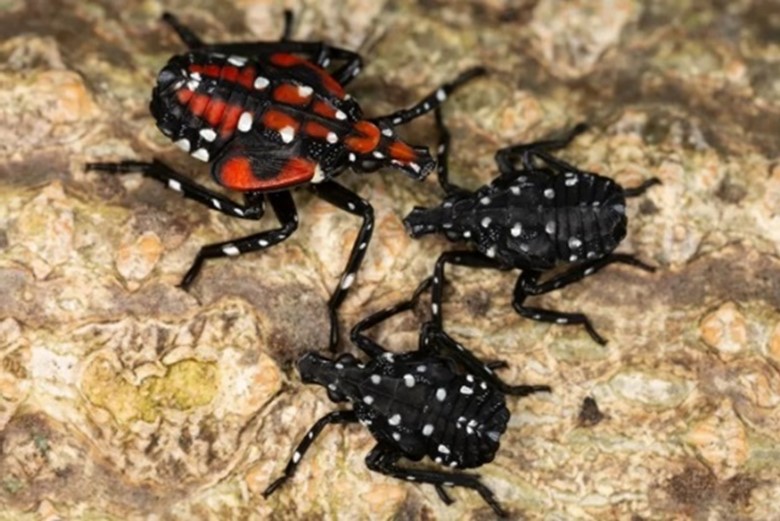
Adults are large, brightly coloured insects approximately 25 mm in length and 12 mm wide with wings folded at rest. The forewings have black spots on a light tan to grey background, with a dark net-like appearance at the tips (Figure 5). When the forewings are open, the exposed hindwings are bright red with spots at the base and black at the tip, separated by a white band (Figure 6). The abdomen is yellow with black bars. Bulbous red antennae on the side of the head are sometimes confused with eyes. Based on observations in Pennsylvania, adults begin to appear mid-July and are active through November, until killed by a hard frost. Activity is not currently expected in December in southern Ontario, but there is a risk of adults being imported accidently from more southern regions in the US. While adults are not considered strong flyers, local dispersal still occurs at a rate of several kilometers per year.
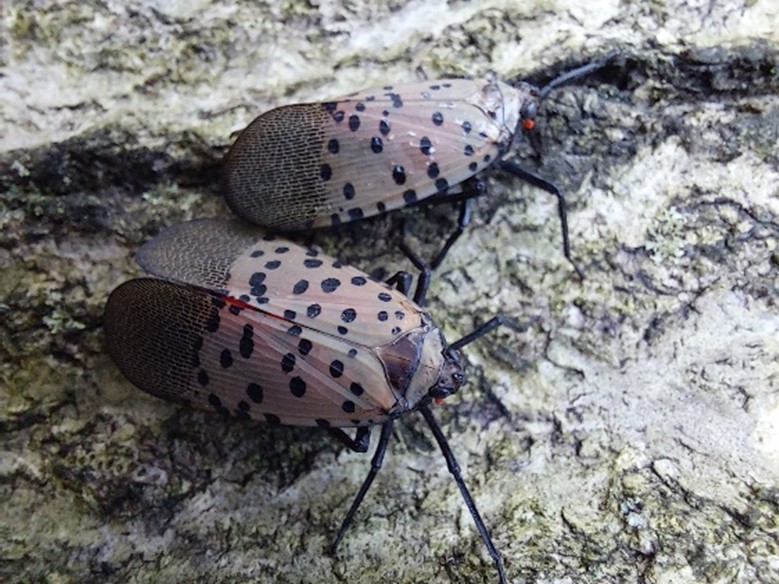
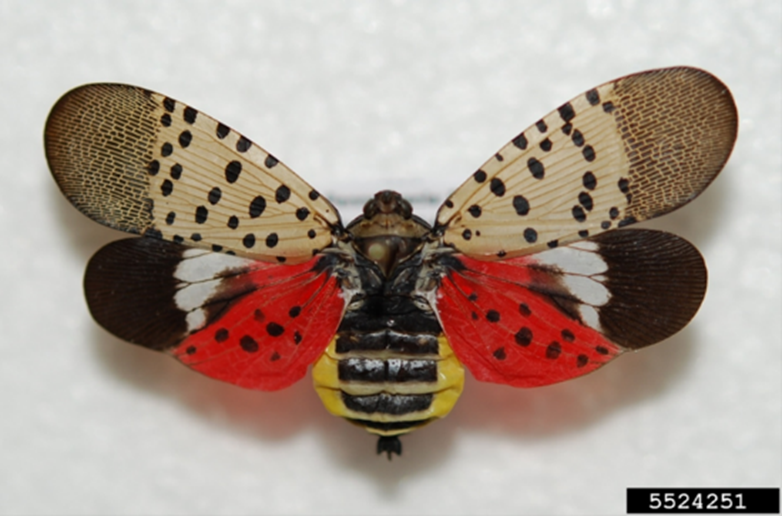
Seasonal host use and scouting
Spotted lanternfly has a large host range that includes agricultural crops, ornamental trees and shrubs, vines and garden perennials. Nymphs feed on the phloem (sap) from tender new growth of herbaceous plants, shrubs and trees, and are constantly moving between hosts. Adults feed on the twigs, branches and trunks of woody plants. Preferred hosts change through the season as plants begin to lose their leaves and deteriorate in the late summer and fall (Table 1). Surveillance programs typically focus on common hosts for detection of SLF in the landscape. Many early detections of SLF populations have occurred on tree of heaven, a preferred host through the growing season.
| Host | Nymphs — May | Nymphs — June | Nymphs — July | Adults — August | Adults — September | Adults — October |
|---|---|---|---|---|---|---|
| Rose (wild, cultivated) | Yes | Yes | No | No | No | No |
| Perennials | Yes | Yes | No | No | No | No |
| Grape (wild, cultivated) | Yes | Yes | Yes | Yes | Yes | Yes |
| Tree-of-heaven | Yes | Yes | Yes | Yes | Yes | Yes |
| Black walnut, butternut | No | Yes | Yes | Yes | Yes | Yes |
| River birch | No | No | Yes | Yes | Yes | Yes |
| Willow | No | No | Yes | Yes | Yes | Yes |
| Sumac | No | No | Yes | Yes | Yes | Yes |
| Red/silver maple | Yes | No | No | No | No | No |
Include scouting for SLF as part of your integrated pest management (IPM) program; this is especially important in vineyards and nurseries, as these are at direct risk from crop injury or indirectly from CFIA regulatory actions, respectively.
Monitoring is limited to visual surveys and passive trapping, as effective lures and trapping systems are still under development. BugBarrier Tree Band (Figure 7) and other sticky trap-based tree banding have been used to support early detection and to help delimit populations in other jurisdictions. These passive traps intercept nymphs and adults as they move up and down trunks and vertical structures, so they need to be placed in areas where the pest is most likely to be present.
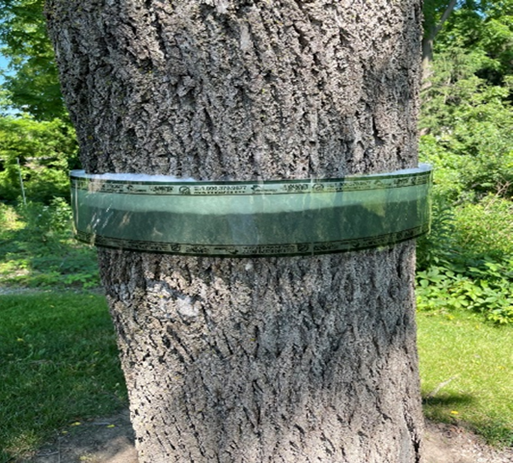
When scouting, consider the following:
- Grape producers and ornamental nurseries should consider weekly monitoring for SLF as part of their IPM programs.
- Scouting vineyards in September and October is especially important, as this is when the adults move into the crop from surrounding wooded areas.
- Check preferred landscape hosts bordering your property/facility including tree of heaven, grapevines (wild and cultivated), black walnut, maples, birch and staghorn sumac.
- Adults will favour and often aggregate on “hot” landscape trees, potentially making them or symptoms easier to detect.
- Don’t limit your search to obvious places: Egg masses are often deposited in sheltered locations, so make sure to look on the underside of branches and under loose bark.
- Females often lay their eggs on or near other egg masses, resulting in a clumped distribution on host plants or other surfaces.
- Look for symptoms of SLF feeding including honeydew on foliage and on surfaces of anything under plants, with associated buildup of black sooty mould fungus (Figure 8).
- Other symptoms include weeping trails of sap on tree trunks, the presence of a strong fermented odour or an increase in bee, ant and wasp activity (attracted to exposed sap and honeydew) (Figure 9).
- Sticky tree bands can be used at high-risk locations, such as in or near shipping and receiving areas. They can be placed on common host trees surrounding production areas or directly on support posts in vineyards.
- Contact the CFIA immediately if any suspect SLF life stage is detected. Contact the CFIA through their contact page.
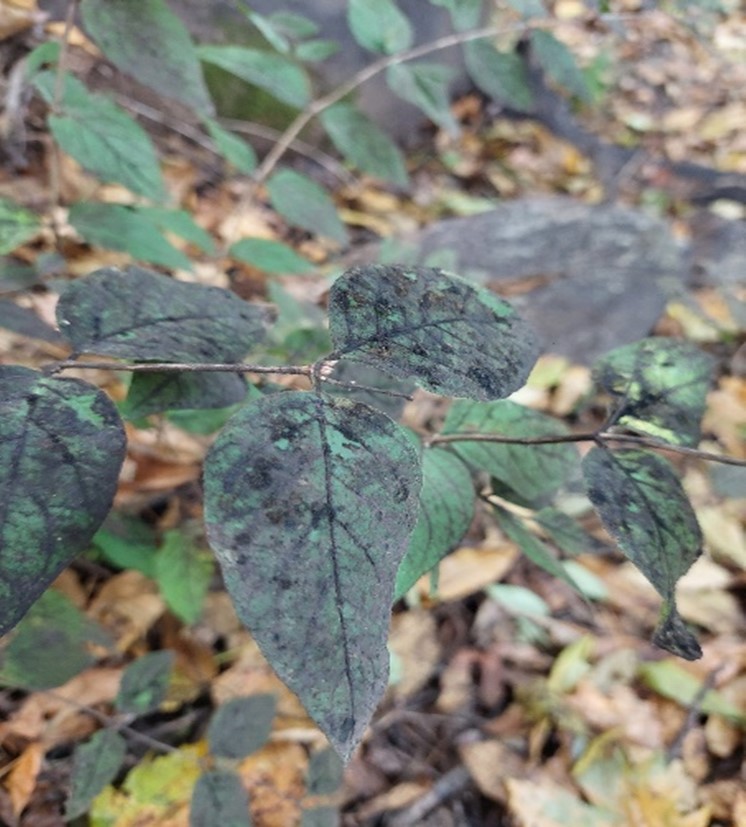
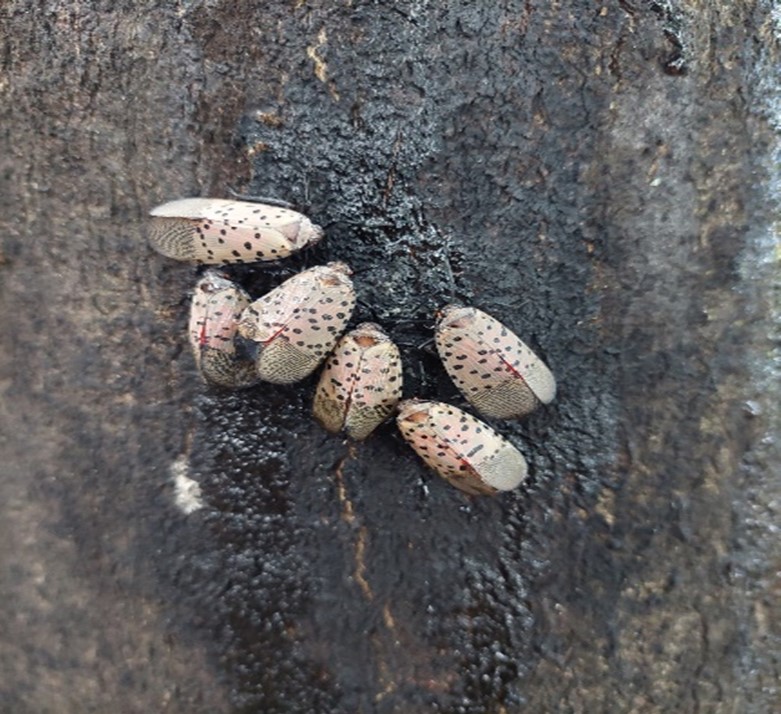
Current management options
While SLF has not been found in Canada, integrated pest management (IPM) recommendations for limiting economic injury caused by the pest have been developed in other jurisdictions. The following information is provided to help guide producers at immediate risk following detection of an established population in Ontario. If you believe you have found SLF, contact the CFIA immediately through their contact page.
Grapevines are at risk from feeding injury caused by swarms of late instar nymphs and adults that typically invade the crop late in the season. Border sprays may be sufficient for managing incoming SLF, as numbers are often concentrated in plants along vineyard edges. Action thresholds, or pest density at which control measures should be implemented to prevent it from reaching economic injury level, are still under development.
Ornamental plants grown in a nursey are also at risk from injury. Feeding from nymphs and adults can cause negative impacts to plant health as well as decrease aesthetics due to secondary damage such as buildup of honeydew and sooty mould. Younger plants and seedlings of preferred hosts like black walnut may be at greater risk from feeding damage and possible plant death. Good agronomic practices used to help keep plants healthy will help reduce additional stress caused by SLF feeding. Markets and CFIA phytosanitary requirements for shipping plant material will determine action thresholds at nurseries.
Fresh egg masses can be physically removed and destroyed by scraping them with a flat, rigid implement such as a credit card or putty knife. Make sure to apply sufficient pressure to completely crush the eggs, as those that remain intact may still hatch. Eggs may also be scraped directly into a small bag containing ethanol, rubbing alcohol, hand sanitizer, or vinegar.
Except where required to meet phytosanitary or market requirements, management of egg masses in vineyards and other commercial crops is not a common practice in other jurisdictions. Mechanical removal is labour intensive and while horticultural oils are effective for smothering eggs, thorough coverage is required. Early instar nymphs that hatch from eggs laid in the crop the previous fall seldom cause economic injury and are usually killed by insecticides used for other pests. Most egg masses laid in trees are found in the upper portion of the canopy, making them difficult to reach.
Several commercial insecticides are fully labelled in Canada for suppression or control of SLF nymphs and adults. As of the date of publication (June 2024) of this infosheet the following insecticides can be used in Canada:
- Kopa Insecticidal Soap is registered for suppression of SLF nymphs in tree fruit, grapes, ornamental and shade trees, and outdoor flowering, foliage and bedding plants.
- Altus Insecticide (flupyradifurone, group 4D) is registered for suppression of SLF (nymphs, adults) on outdoor nursery and landscape ornamental plants, including flowers, foliage plants, shrubs, trees and groundcovers.
- Sivanto Prime (flupyradifurone, group 4D) is registered for suppression of SLF (nymphs, adults) on pome fruits, stone fruits and grapes.
- Danitol (fenpropathrin, group 3) is registered for control of SLF (nymphs, adults) on pome and stone fruits.
For more information and updates, visit the Pest Management Regulatory Agency website.
Training and customer outreach
Late instar nymphs and adults are large, brightly coloured insects that are relatively easy to identify. Take advantage of their dramatic appearance to:
- Provide all employees with training on how to identify different SLF life stages.
- Raise awareness among retailers, customers, and the general public who visit your operation through signage and resources on SLF.
Wineries and other popular tourist destinations in agricultural areas are at high risk for introduction from infested regions, especially in the fall when adults are active, and females are laying eggs. Remind visitors to check their vehicles for SLF, especially those coming from infested areas.
Visit the Invasive Species Centre website for information on their free SLF Training Program. Ontario Certified Crop Advisor Association (CCA) and/or ISA Continuing Education Units are available for those completing the training.
Reporting
SLF has not been detected in the Canadian landscape, but there have been observations made in multiple provinces including Ontario. The CFIA uses the following terms to describe observations of SLF in Canada:
- Sighting: Reports of spotted lanternfly in Canada that the CFIA is aware of, including those made on public reporting sites (for example, iNaturalist Canada, Facebook, etc.). Sightings are not confirmed by the CFIA.
- Interception: Live spotted lanternfly, confirmed by the CFIA, in contained situations (for example, warehouse) with no evidence of release to the Canadian environment; and/or dead spotted lanternfly, confirmed by the CFIA.
- Detection: Live spotted lanternfly, confirmed by the CFIA, in the Canadian environment.
- Established population: Evidence of a reproducing population in the Canadian environment, confirmed by the CFIA.
The CFIA requires an actual specimen to confirm. For updated information on observations of SLF in Canada, see the CFIA website. Early detection of SLF is critical to support response efforts and to slow the spread in Canada once found. If you think you have found SLF:
- Take a picture, collect a sample (if possible) or destroy, and contact the CFIA immediately through their contact page.
- For photographs, a clear image of the specimen is needed for species confirmation.
- If collecting samples, place eggs, nymphs or adults into a sealed container or plastic bag containing alcohol or vinegar to kill them. Eggs can be scraped into the container or bag with a knife or credit card. Do not transport live specimens.
- Information including precise location (GPS coordinates if possible), date and items/plant on which the specimens were found should be included in your submission. Consider flagging or marking the area the sample was collected from to make it easier to identify when revisiting the area.
- Isolate and contain any infested plant material or equipment immediately to limit potential escape of active life stages (nymphs, adults).
- Where possible, consider the use of registered pest control products to help reduce spread of active life stages (nymphs, adults). Eggs can be scraped off surfaces and squished/crushed and/or placed into alcohol/vinegar to kill them.
Accessible image description
Figure 1. Seasonal biology of spotted lanternfly in Pennsylvania. Source: Invasive Species Centre.
Spotted Lanternfly life cycle
- 1st to 3rd instars (0.3 to 0.7 cm)
- 1st instar: May – June
- 2nd instar: June – July
- 3rd instar: June – July
- 4th instar (approximately 1.3 cm): July – September
- Adult (2 to 3 cm): July – December
- Egg laying: September – December
- 2–5 segmented rows
- 2.5 cm
- Often, but not always covered
- Egg masses: December – June